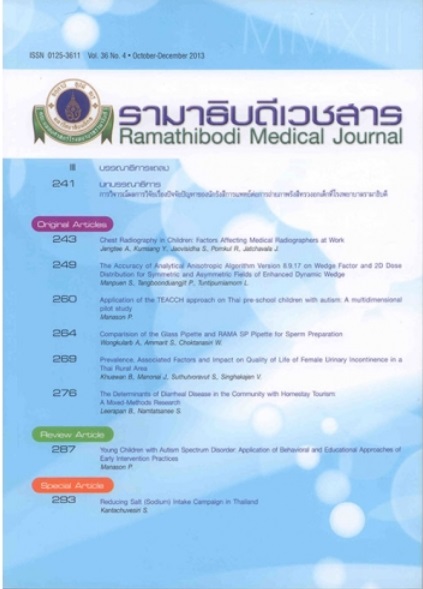The Determinants of Diarrheal Disease in the Community with Homestay Tourism: A Mixed-Methods Research
Keywords:
Diarrheal disease, Health determinan, Community potentials, Disease prevention and controlAbstract
Background: Diarrheal epidemics in communities with homestay tourism can be more than health problems-they also can damage the local economics.
Objective: This study investigated health determinants in a homestay village and its community resources that could contribute to diarrheal prevention and control.
Methods: This observational study employed a mixed-methods research design. Study population included all residents of the homestay village of Khok Kong (N = 557). Quantitative data were obtained by a cross-sectional survey using a simple random sampling (n = 47), and analyzed by chi-squared test and multivariate logistic regression. Quantitative data were collected by participant observations, and analyzed by content analysis.
Results: 23% of the samples experienced acute diarrhea in the last three months, which are associated with habit of washing hands before meals (odds ratio [OR] = 0.16, P = 0.010) and with female gender (OR = 0.19, P = 0.025). The relationship remains significant after controlling for gender (OR = 0.22, P = 0.048). Statistical analysis suggests the villagers with good hand hygiene less likely had diarrhea. No evidence of relationships between types of food and drinking water and diarrhea is found in this community. Content analysis revealed “adequate hygiene for cooking and eating within households”, “poor sanitization of local restaurants and grocery stores”, “good health literacy”, and “community potentials for self-development”.
Conclusions: Statistical findings from the survey are matched with results from content analysis, which revealed that diarrheal prevention was empowered in most households. Outside the households, however, food safety approved to be insufficient and could be a potential source of diarrheal widespread.
References
Fischer Walker CL, Perin J, Aryee MJ, Boschi-Pinto C, Black RE. Diarrhea incidence in low- and middle-income countries in 1990 and 2010: a systematic review. BMC Public Health. 2012;12:220. doi:10.1186/1471-2458-12-220.
Walker CLF, Rudan I, Liu L, et al. Global burden of childhood pneumonia and diarrhoea. Lancet. 2013;381(9875):1405-1416. doi:10.1016/S0140-6736(13)60222-6.
World Health Organization. Diarrhoeal disease 2013. Available from: https://www.who.int/mediacentre/factsheets/fs330/en/.
Chongsuvivatwong V, Mo-suwan L, Chompikul J, Vitsupakorn K, McNeil D. Effects of piped water supply on the incidence of diarrheal diseases in children in southern Thailand. Southeast Asian J Trop Med Public Health. 1994;25(4):628-632.
Yotthanooi S, Choonpradub C. A statistical method for estimating under-reported incidence rates with application to child diarrhea in Thai provinces bordering Cambodia. Southeast Asian J Trop Med Public Health. 2010;41(1):203-214.
Kuchinarai Crown Prince Hospital. Annual report of Kuchinarai Crown Prince Hospital in the fiscal year of 2012. Kalasin, Thailand Ministry of Public Health, 2013.
Mollerup A. Phu Tai History 2012. [cite 2013]. Available from: https://www.phutai.thai-isan-lao.com/Phutai-history.html.
Research Center for Mekong Regional Tourism. Khok Kong Phu Thai Cultural Village Khon Kean, Thailand: Khon Kean University: 2012. Available from: https://recmert.kku.ac.th/webthai/administrator/file/tourist/bankhokkong.pdf.
Creswell JW, Fetters MD, Ivankova NV. Designing a mixed methods Study in Primary Care. Annals Fam Med. 2004;2:7-12.
Creswell JW. Research design: Qualitative, quantitative, and mixed methods approaches/John W Creswell. Thousand Oaks, California: SAGE Publications, Inc.: 2009.
Centers for Disease Control and Prevention. Epi Info 7.1 ed. Atlanta GA: Centers for Disease Control and Prevention; 2012.
Bureau of Epidemiology, Diarrhoeal surveillance form. Nonthaburi, Thailand: Bureau of Epidemiology, Department of Disease Control, Ministry of Public Health; 2012.
Strauss K, MacLean C, Troy A, Littenberg B. Driving distance as a barrier to glycemic control in diabetes. J Gen Intern Med. 2006;21(4):378-380.
Luby SP, Curtis V. Hand washing for preventing diarrhoea. Int J Epidemiol. 2008 Jun;37(3):470-473. doi:10.1093/ije/dyn069.
Luby SP, Agboatwalla M, Feikin DR, et al. Effect of handwashing on child health: a randomised controlled trial. Lancet. 2005;366(9481):225-233.
Curtis VA, Danquah LO, Aunger RV. Planned, motivated and habitual hygiene behaviour: an eleven country review. Health Educ Res. 2009;24(4):655-673. doi:10.1093/her/cyp002.
Scott B, Curtis V, Rabie T, Garbrah-Aidoo N. Health in our hands, but not in our heads: understanding hygiene motivation in Ghana. Health Policy Plan. 2007;22(4):225-233.













